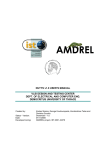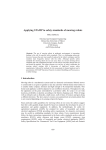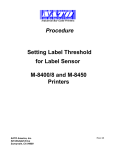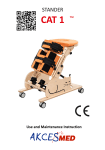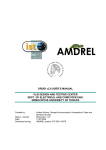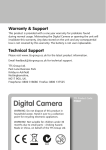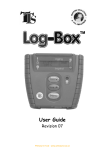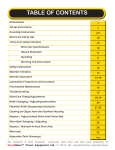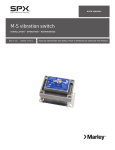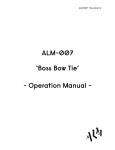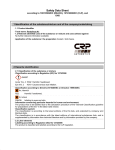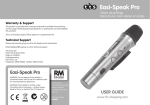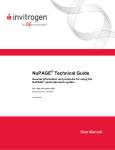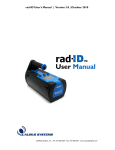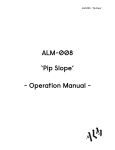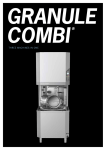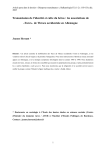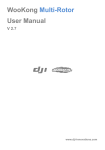Download Eleftheria Mitka, Applying STAMP to safety standards of
Transcript
Applying STAMP to safety standards of mowing robots Mitka Eleftheria Democritus University of Thrace, Electrical and Computer Engineering, School of Engineering, Greece Contact details: [email protected] Presentation for: 2nd European STAMP Workshop 2014 ©Copyright Mitka Eleftheria, September 2014 Useful tools in determining how adequate safety potential behaviour can be achieved by a system, especially with respect to its interaction with other systems. Define the design and production activities and offer enough confidence that these guidelines are actually contented in any specific level of the system. ©Copyright Mitka Eleftheria, September 2014 Describe a compromise as to what constitutes best practice in achieving safety in systems, and what comprises best practice in the design level used for the production. Since specific safety standards for robotic mowers are not available yet, I propose that they should be carried out on the base of STAMP that is discussed here. ©Copyright Mitka Eleftheria, September 2014 Automatically mow lawn at any day and time delimited by perimeter wire Small, compact, silent and easy to transport Its performance depends on weather conditions (sunlight and temperature), shape of garden, state of blades, growth of grass and humidity Whenever it comes in contact with an obstacle, it reverses and follows a different direction Uses an irregular movement pattern that is never repeated, according to its sensors ©Copyright Mitka Eleftheria, September 2014 ANSI/ASAE S318: Safety for Agricultural Equipment ANSI/ASAE S323: Definitions of Powered Lawn and Garden Equipment ANSI B71.4: Safety Specifications for Commercial Turf Care Equipment ANSI/OPEI B71.1: Safety Specifications for Turf Care Equipment – Power Lawn Mowers, Lawn and Garden Tractors ASAE S441: Safety Signs Safety certification requirements for domestic robots [published by the author in Safety Science] ©Copyright Mitka Eleftheria, September 2014 With aim to expand and grow the acceptance of mowing robots by the society, the author proposes a new list of safety constraints, user information and observations based on STAMP. ©Copyright Mitka Eleftheria, September 2014 A1. Explosion of the robot due to improper storing A2. Explosion of the robot due to flames/spark from barbecue A3. The user is changing the operating program A4. An abnormal high speed movement not blocked by the emergency stop button A5. The perimeter wire is cut leading to breakdown of the robot. A6. The mower chassis has burnt signs or signs of corrosion leading to eye/skin damage A7. The drive motors are damaged due to severe overloading of the wheel motors ©Copyright Mitka Eleftheria, September 2014 A8. The robot doesn’t warn about restart or scheduled programming operation A9. The mower is mowing outside the yard and not across the perimeter wire A10. Loose objects thrown by the blades A11. The collision detection system of the device is not functioning leading to trapping points A12. The equipment of the lawn mower starts vibrating abnormally. A13. Electrical component damage due to inadequate cleaning ©Copyright Mitka Eleftheria, September 2014 A15. Contact with the blades A16. A child fall off while he rides on an operating robot A17. A resident hits a person by pulling the mower backward without looking. A18. Body part caught in the exposed mechanism due to indented opening of the cover ©Copyright Mitka Eleftheria, September 2014 Level 1: A1-1: The collision detection system of the device is not functioning. A1-2: A resident is mowing over an obstacle. A1-3: The mower is mowing outside the yard hitting someone. A1-4: The user is changing the operating program leading to a harmful injury. A1-5: Vapor may reach a flame or a spark causing an explosion of the device. A1-6: Explosion of the device caused by storing the device in an improper place. A1-7: Rotating blades catches part of resident’s body. A1-8: Coming in contact with any exposed mechanism part of the robot. A1-9: A child rides on an operating robot. A1-10: A resident is pulling the mower backward without paying attention. Level 2: A2-1: A pet or children could be pinned under the robot. A2-2: The mower chassis has burnt signs or signs of corrosion ©Copyright Mitka Eleftheria, September 2014 Level 3: A3-1: An abnormal high speed movement is not blocked by the stop button. A3-2: Inability of the device to follow the tasking path. A3-3: Water and other liquids causing damage of electrical connections. A3-4: The mowing equipment starts vibrating abnormally. A3-5: The drive motors are damaged due to severe overloading of the wheel motors. A3-6: The robot ceases its operation due to cut of the perimeter wire. ©Copyright Mitka Eleftheria, September 2014 Mechanical Hazard (Crushing, Shearing, Cutting or severing, Entanglement, Impact, High pressure fluid injection, Shape, Acceleration/deceleration, inadequate mechanical strengths, Mass and velocity, Potential elements or elastic elements). Electrical Hazard (Contacts of persons with live parts, Breakdown, Leakage current, Electrostatic phenomena, Thermal radiation) Hazard generated by vibration (White-finger disease, Neurological, osteoarticular disorders) Hazard generated by radiation (electromagnetic fields, infra-red light, visible light and ultra-violet, light Laser radiation, X and γ rays, α and β rays, electron or ion beams, neutrons, ionizing or non-ionizing radiation) Thermal Hazard (Burns and scalds) Hazards generated by neglecting ergonomic principles in machine (physiological and psycho-physiological effects, human errors) Slipping, tripping and falling hazards. Hazard generated by materials and substances (ingestion, inhalation of fluids, gases, mists, fumes, fibers, dusts or aerosols (harmful, toxic, corrosive, teratogenic, carcinogenic, mutagenic, irritant or sensitizing effect, biological hazards)) Environmental Hazards (temperature, wind, snow, lightning, vapor, explosive or flammable atmospheres) H1. Mechanical (cutting, severing, inadequate velocity) [A4, A7, A10, A12, A14, A15] H2. Environmental (explosion) [A1, A2] H3. Tripping and falling [A9, A11, A16, A17] H4. Hazards generated by substances [A6] H5. Electrical [A5, A8] H6. Hazards generated by neglecting ergonomic principles in machine [A3, A13, A18] ©Copyright Mitka Eleftheria, September 2014 Identify the safety constraints - 1 Remove the power plug from the charging station in case of storing the robot. Explosion of the device due to improper storing Environmental hazard. Do not leave containers with grass cuttings in the storage or charging area of the device. Stored in a sheltered and dry place with good ventilation and lightning conditions. To reduce the fire hazard, keep the robot, charging station and storage area free of grass, leaves, or excessive grease. ©Copyright Mitka Eleftheria, September 2014 Identify the safety constraints - 2 Exposed mechanism Mechanical Hazard The mowing covering hood shall not collect grass residuals after mowing damp or wet lawn. It shall be inspected and maintained regularly for foreign material using a damp cloth or another similar tool. The mechanism of the mowing robot shall be protected with plastic cover to prevent from bumping or changing it ©Copyright Mitka Eleftheria, September 2014 Identify the safety constraints - 3 The mower explodes due to flame or spark Environmental Hazard Always keep the mower away from water, heat sources (stoves, radiators, open flames, water heater) and hazardous chemicals to avoid electrocution, overheating or chemical burn hazard. Human–robot environment (chemical, thermal conditions). If gasses, liquids or combustible substances are contained inside the robot, the designer should ensure that any increase of temperature will not cause burn injury. ©Copyright Mitka Eleftheria, September 2014 Identify the safety constraints - 4 Contact with the sharp rotating blades Mechanical Hazard Manual should advice the user to present dramatic description on the hazardous behaviors of mistreating the robot and warn correctly concerning the appropriate safety features. User’s manual indicates that every maintenance, service, replacement or inspection of worn or damaged parts should be carried out by service experts. ©Copyright Mitka Eleftheria, September 2014 Identify the safety constraints - 5 Pulling the mower backwards without looking Tripping Hazard Online tutorials and help menus shall contain the appropriate instructions, so that users shall have direct access to information on how to operate the robot. A built-in electronic hardware control system and/or safety operational software shall be selected to force the robot to shut itself down in an emergency. ©Copyright Mitka Eleftheria, September 2014 Identify the safety constraints - 6 The user is changing the operating program Neglecting ergonomic principles of machine Settings that could be stored in ROM might include: manual user options, user preferences, charging options, safety tests, information, temperature, software version, charging voltage, charging temperature, entry points, child guard, lock settings, alarm function, rain sensor, auto setup, sound, date and distance format, time, signal type, lock keyboard, scan width, zones setup, first time calibration and ground clearance, follow loop, garden shape. Faulty programming may result in anti-theft alarm don’t stop beeping or not operating, incorrect set of clock, incorrect work time, not enough work hours, not completely mowed the secondary area, the remote control don’t work. ©Copyright Mitka Eleftheria, September 2014 Identify the safety constraints - 7 Loose objects Mechanical Hazard User shall not operate the robot for trimming hedges, for mowing vegetation other than grass, for leaf or debris collection, or on grounds other than mowing field, for pulling or carrying loads. User should not mow over gravel, stones or hard, immovable objects like pipes, rocks or sidewalk edges or objects like blind corners, shrubs, trees with holes or flower around it that might obscure vision. ©Copyright Mitka Eleftheria, September 2014 Identify the safety constraints - 8 The mower is mowing outside the yard leading to falling and tripping hazards User shall not use an extension cord to increase this distance from power receptacle. This event may be due to the perimeter wire being routed in the wrong direction around an obstacle, which blocks the signal. User shall pay extra attention if the area around the mowing field is populated or congested. Always look for traffic when mowing near roadways, walks or gravel drives. ©Copyright Mitka Eleftheria, September 2014 Identify the safety constraints - 9 The collision detection system of not functioning Trapping points. Obstacles such as trees, flower beds, fountains or bushes higher than 15 cm shall not have to be delimited by the perimeter wire. Mower will bang and bounce when it collides with this type of obstacle creating an island around them. The perimeter wire shall not be laid around an object that robot can be allowed to collide with, like a fence or a dense hedge. ©Copyright Mitka Eleftheria, September 2014 Identify the safety constraints - 10 Visually check for any damage of the blade or mowing chassis and search directly for the cause The equipment of lawn mower starts vibrating abnormally Mechanical hazard Remove the power plug from mower, in case that it begins trembling irregularly. User shall check the blades and screws and replace them if they are damaged. The malfunction that leads to continuous vibration has to be repaired by service experts. ©Copyright Mitka Eleftheria, September 2014 Identify the safety constraints - 11 A child rides on an operating robot Falling hazard Warning signs shall be established to protect residents who may consider that they can ceaselessly be reckless with the operating robot. Specific responsibilities concerning safety shall be assigned to an adult user. The robot shall be equipped with a specific audio or visual signal, easily recognizable by everyone, to let people know whether it is on or off. ©Copyright Mitka Eleftheria, September 2014 Identify the safety constraints - 12 Electrical of electronic component damage due to inadequate cleaning of the robotic device User or residents shall not spray water towards the robot, the charging station or the panel of the station. Never use the charger or charge the device in grasses with dampness or when wet contact is expected. User must not, under all circumstances, remove, bend, and cut, fit, weld electrical or electronic parts inside the chassis of the robot. ©Copyright Mitka Eleftheria, September 2014 Identify the safety constraints - 13 Residents should be informed by the user for the user-programmed automatic weekly scheduled day and time. A pet or children could be pinned under the robot if the alarm of the robot doesn’t warn about restart or scheduled programming operation The robot may restart its operation elsewhere especially near obstacles (fallen branches, forgotten objects) due to severe load on wheel drive motors, unknown fault, temporary power loss, after a long period of inactivity or after the replacement of the blades. Control access of small children before mow in reverse, up and down via manual control. User should ensure that children younger than 6 are indoors. ©Copyright Mitka Eleftheria, September 2014 Frequently clean the charging station and the robotic contacts using only a damp cloth. The mower chassis has burnt signs or signs of corrosion leading to hazard generated by materials and substances. Use only a damp, soft sponge or cloth and a dry brush to wipe the outer surfaces after scraping. User shall not use harsh or abrasive cleaning solutions. If the chassis remains dirty, a soap or washingup liquid might be necessary. User shall not wash the inherent components so as not damage electric and electronic elements since mower is non-waterproof. ©Copyright Mitka Eleftheria, September 2014 A helpful method in the attempt to analyse the entire robotic mower system STAMP provides a structured way to estimate the system and recognise weak points. Leading safety performance constraints can be proposed based on the method. ©Copyright Mitka Eleftheria, September 2014 Thank you! Mitka Eleftheria PhD Candidate Department of Electrical & Computer Engineering School of Engineering, Democritus University of Thrace, University Campus, Greece [email protected]






























